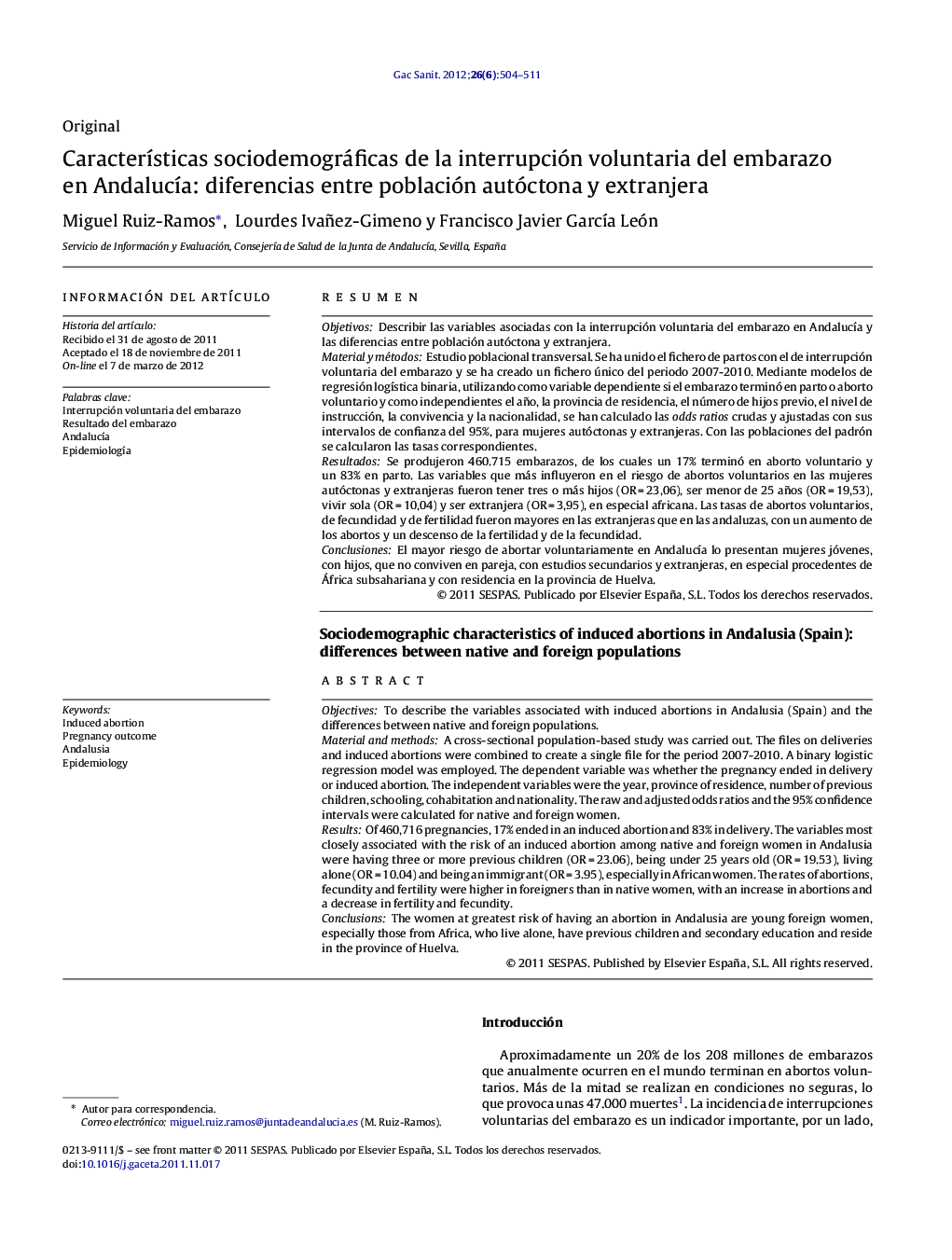| کد مقاله | کد نشریه | سال انتشار | مقاله انگلیسی | نسخه تمام متن |
|---|---|---|---|---|
| 1073454 | 949787 | 2012 | 8 صفحه PDF | دانلود رایگان |

ResumenObjetivosDescribir las variables asociadas con la interrupción voluntaria del embarazo en Andalucía y las diferencias entre población autóctona y extranjera.Material y métodosEstudio poblacional transversal. Se ha unido el fichero de partos con el de interrupción voluntaria del embarazo y se ha creado un fichero único del periodo 2007-2010. Mediante modelos de regresión logística binaria, utilizando como variable dependiente si el embarazo terminó en parto o aborto voluntario y como independientes el año, la provincia de residencia, el número de hijos previo, el nivel de instrucción, la convivencia y la nacionalidad, se han calculado las odds ratios crudas y ajustadas con sus intervalos de confianza del 95%, para mujeres autóctonas y extranjeras. Con las poblaciones del padrón se calcularon las tasas correspondientes.ResultadosSe produjeron 460.715 embarazos, de los cuales un 17% terminó en aborto voluntario y un 83% en parto. Las variables que más influyeron en el riesgo de abortos voluntarios en las mujeres autóctonas y extranjeras fueron tener tres o más hijos (OR = 23,06), ser menor de 25 años (OR = 19,53), vivir sola (OR = 10,04) y ser extranjera (OR = 3,95), en especial africana. Las tasas de abortos voluntarios, de fecundidad y de fertilidad fueron mayores en las extranjeras que en las andaluzas, con un aumento de los abortos y un descenso de la fertilidad y de la fecundidad.ConclusionesEl mayor riesgo de abortar voluntariamente en Andalucía lo presentan mujeres jóvenes, con hijos, que no conviven en pareja, con estudios secundarios y extranjeras, en especial procedentes de África subsahariana y con residencia en la provincia de Huelva.
ObjectivesTo describe the variables associated with induced abortions in Andalusia (Spain) and the differences between native and foreign populations.Material and methodsA cross-sectional population-based study was carried out. The files on deliveries and induced abortions were combined to create a single file for the period 2007-2010. A binary logistic regression model was employed. The dependent variable was whether the pregnancy ended in delivery or induced abortion. The independent variables were the year, province of residence, number of previous children, schooling, cohabitation and nationality. The raw and adjusted odds ratios and the 95% confidence intervals were calculated for native and foreign women.ResultsOf 460,716 pregnancies, 17% ended in an induced abortion and 83% in delivery. The variables most closely associated with the risk of an induced abortion among native and foreign women in Andalusia were having three or more previous children (OR = 23.06), being under 25 years old (OR = 19.53), living alone (OR = 10.04) and being an immigrant (OR = 3.95), especially in African women. The rates of abortions, fecundity and fertility were higher in foreigners than in native women, with an increase in abortions and a decrease in fertility and fecundity.ConclusionsThe women at greatest risk of having an abortion in Andalusia are young foreign women, especially those from Africa, who live alone, have previous children and secondary education and reside in the province of Huelva.
Journal: Gaceta Sanitaria - Volume 26, Issue 6, November–December 2012, Pages 504–511